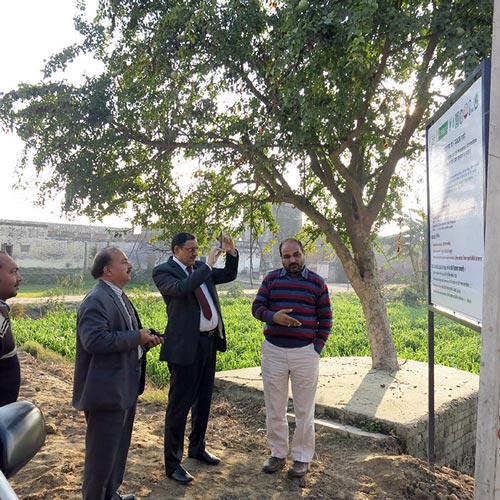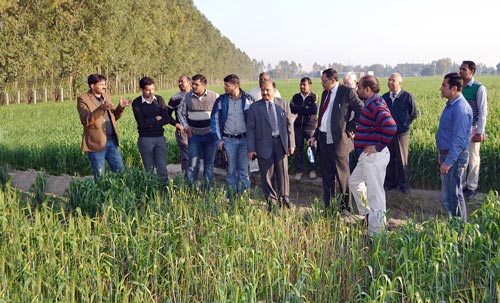By M.L. Jat, Tripti Agarwal, R.S. Dadarwal and Promil Kapur/ CIMMYT and CCAFS
To witness firsthand the mainstreaming of climate-smart agriculture practices and innovative community-based adaptation strategies in India, Alok K. Sikka, deputy director general of the Natural Resource Management Division of the Indian Council of Agriculture Research’s (ICAR) and leader of ICAR’s National Initiative on Climate Resilient Agriculture (NICRA), visited and interacted with farmers at a climate-smart village (CSV) in Haryana on 11 February.

He was accompanied by D.K. Sharma, director of the Central Soil Salinity Research Institute, and P.C. Sharma, one of the Institute’s principal scientists, along with other scientists from ICAR and CIMMYT. Participants agreed that South Asian agriculture needs new technologies, community-based adaptation of relevant practices and the strengthening of local decision-making. The 27 CSVs being piloted in Haryana, India, will disseminate key climate-smart agricultural interventions, focusing on water, energy, carbon nutrient, weather and knowledge implemented through innovative partnerships and farmer cooperatives, according to M.L. Jat, CIMMYT senior cropping system agronomist.
The climate-smart villages are implemented through the CGIAR Research Program on Climate Change, Agriculture and Food Security (CCAFS), in close collaboration with NICRA and a range of innovative partnerships. Under CCAFS, CIMMYT in close collaboration with national agriculture research and extension systems, other CGIAR centers, farmer cooperatives, the Haryana Department of Agriculture and policy planners, have piloted several CSVs in Haryana for research and as learning sites. Sustainable intensification and conservation agriculture-based management systems are the key areas in which CIMMYT and these partners work together.
Visitors interacted with farmers and members of farmer cooperatives who are actively disseminating the practices to local communities. The model of innovation platforms for strategic participatory research and learning at CSVs was recognized as an effective method to link science with society. Sikka emphasized that the depleting water table, deteriorating soil health, escalating input costs and weather uncertainties constitute critical concerns and that current production systems are not sustainable.

He cited conservation agriculture-based sustainable intensification, supplemented by more precise use of inputs like fertilizer, as the way to achieve resilience in production and natural resource conservation. Institutions and organizations must work with emerging technologies to address climate change and provide relevant options for farmers. CCAFS and NICRA are good examples of this.
 Climate adaptation and mitigation
Climate adaptation and mitigation